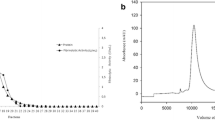Abstract
The bacterial protein staphylocoagulase binds stoichiometrically to human prothrombin, resulting in a coagulant complex, staphylothrombin. The enzymatic properties of staphylothrombin differ from those of α-thrombin in their substrate specificities toward natural and synthetic substrates, in addition to their interaction with protease inhibitors. In order to obtain information about the region of staphylocoagulase that interacts with human prothrombin, staphylocoagulase was cleaved by α-chymotrypsin. Limited α-chymotryptic cleavage of staphylocoagulase yielded three large fragments, of 43, 30, and 20 kD. The 43-kD fragment exhibited a high affinity for human prothrombin (Kd=1.7 nM), which is comparable to the affinity observed using intact staphylocoagulase (Kd=0.46 nM). A complex of the 43-kD fragment and prothrombin possessed both clotting and amidase activity essentially identical to that observed in a complex of intact staphylocoagulase and prothrombin. The 30-kD fragment exhibited weaker affinity for prothrombin (Kd=120 nM.) While clotting activity was not observed with a complex of this fragment and prothrombin, it nonetheless possessed a weak amidase activity. The 20-kD fragment was found only to bind to prothrombin. The NH2-terminal sequence analyses of these fragments revealed that the 43-kD fragment constitutes the NH2-terminal portion of staphylocoagulase, and contains the 30-kD and 20-kD fragments. It is therefore concluded that the functional region of staphylocoagulase for binding and activation of prothrombin is localized in the NH2-terminal region of the intact protein. The 43-kD fragment contained 324 amino acids with a molecular weight of 38,098. The 43-kD fragment had an unusual amino acid composition based on a sequence in which the sum of Asp (28 residues), Asn (22), Glu (35), Gln (9), and Lys (52) residues accounted for more than 45% of the total. A comparison of the amino acid sequence of the 43-kD fragment with that of streptokinase did not reveal any obvious sequence homology. There was also no sequence homology with that of trypsin, α-chymotrypsin, and elastase.
Similar content being viewed by others
References
Chou P. Y., and Fasman G. D. (1974). Biochemistry 13, 211–222.
Chou P. Y., and Fasman G. D. (1978). Annu. Rev. Biochem. 47, 251–276.
Hemker H. C., Bas B. M., and Muller A. D. (1975). Biochim. Biophys. Acta 379, 311–319.
Hendrix H., Lindhout T., Mentens K., Engels W., and Hemker H. C. (1983). J. Biol. Chem. 258, 3637–3644.
Hummel B. C. W. (1959). Can. J. Biochem. Physiol. 37, 1393.
Igarashi H., Morita T., and Iwanaga S. (1979). J. Biochem. 86, 1615–1618.
Jackson K. W., and Tang J. (1982). Biochemistry 21, 6620–6625.
Jackson K. W., Esmon N., and Tang J. (1981). Meth. Enzymol. 80, 387–394.
Kaufman E., Geisler N., and Weber K. (1984). FEBS Lett. 170, 81–84.
Kawabata S., Morita T., Iwanaga S., and Igarashi H. (1985a). J. Biochem. 97, 325–331.
Kawabata S., Morita T., Iwanaga S., and Igarashi H. (1985b). J. Biochem. 97, 1073–1078.
Kawabata S., Morita T., Iwanaga S., and Igarashi H. (1985c). J. Biochem. 98, 1603–1614.
Kawabata S., Morita T., Miyata T., Iwanaga S., and Igarashi H. (1986a). J. Biol. Chem., 261, 1427–1433.
Kawabata S., Miyata T., Morita T., Miyata T., Iwanaga S., and Igarashi H. (1986b). J. Biol. Chem., 261, 527–531.
Kettner C., and Shaw E. (1977). In Chemistry and Biology of Thrombin (Lundbald R. L., et al., eds.), Ann Arbor Science Publishers Ann Arbor, Michigan, pp. 129–143.
Kettner C., and Shaw E. (1979). Thromb. Res. 14, 969–973.
Kyte J., and Doolittle R. F. (1982). J. Mol. Biol. 157, 105–132.
Soulier J. P., Prou-Wartelle O., and Halle L. (1970). Thromb. Diath. Haemorrh. 23, 37–49.
Tager M., and Drummond M. C. (1965). Ann. N. Y. Acad. Sci. 128, 92–111.
Toh H., Hayashida H., and Miyata T. (1983). Nature 35, 827–829.
Walker B., Wikstrom P., and Shaw E. (1985). Biochem. J. 230, 645–650.
Zajdel M., Wegrzynowicz Z., Jeljaszewicz J., and Pulverer G. (1973). In Staphylococci and Staphylococcal Infections (Jeljaszewicz J., ed.), S. Karger, Basel, pp. 364–375.
Zajdel M., Wegrzynowicz Z., Sawecka J., Jeljaszewicz J., and Pulverer G. (1976). In Staphylococci and Staphyloccocal Disease (Jeljaszewicz J., ed.), Gustav Fischer Verlag, Stuttgart, pp. 549–575.
Author information
Authors and Affiliations
Additional information
This article was presented during the proceedings of the International Conference on Macromolecular Structure and Function, held at the National Defence Medical College, Tokorozawa, Japan, December 1985.
Rights and permissions
About this article
Cite this article
Kawabata, SI., Morita, T., Miyata, T. et al. Structure and function relationship of staphylocoagulase. J Protein Chem 6, 17–32 (1987). https://doi.org/10.1007/BF00248824
Received:
Published:
Issue Date:
DOI: https://doi.org/10.1007/BF00248824




